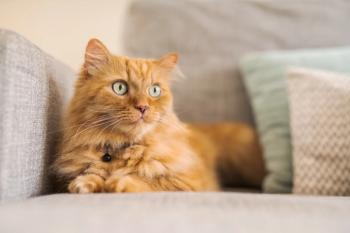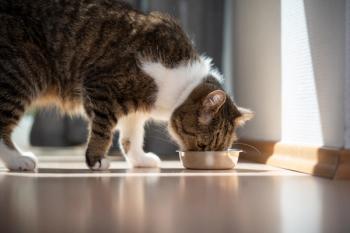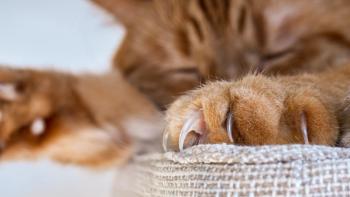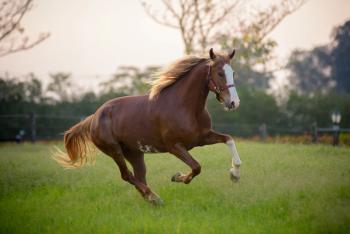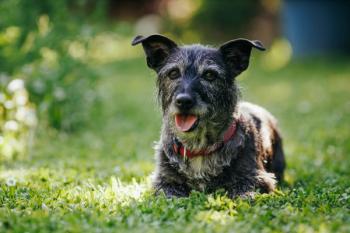
Rewarming a stray kitten
A case example of treating hypothermia.
An approximately 16-week-old neutered male domestic shorthaired kitten was presented to the hospital by a good Samaritan who found it minimally responsive outside on a typical winter day in the Finger Lakes region of New York.
1. A kitten (not the one in this case) in a warm waterbed. To make this waterbed, fill a stainless steel bowl with warm water and then place the bowl inside a large plastic bag. Tie the plastic bag and wrap it around the bowl to allow the patient to lie comfortably on the waterbed. If prolonged use is expected, place a towel between the plastic bag and the patient to prevent thermal injury.
Primary assessment
- Temperature: 91.1 F (32.8 C)
- Heart rate: 128 beats/min; respiratory rate: 22 breaths/min
- A (airway): patent airway
- B (breathing): unremarkable lung sounds
- C (circulation): no murmur; weak synchronous pulses; capillary refill time > 5 sec
- Level of consciousness: minimally responsive, unable to maintain sternal recumbency
Initial diagnostic evaluation
- Doppler blood pressure: 44 mm Hg systolic
- Packed cell volume/total solids (PCV/TS): 57%/8.8 g/dl (PCV reference range = 34% to 48%; TS reference range = 6.5 to 7.6 g/dl)
- Venous blood gas: pH = 7.103 (reference range = 7.4 ± 0.04); bicarbonate = 9 mmol/L (reference range = 20 ± 4 mmol/L); base excess = -16 mmol/L (reference range = 0 ± 4 mmol/L); PvCO2 = 47 mm Hg (reference range= 40 ± 4 mm Hg)
- Electrolyte panel: Potassium = 2.76 mmol/L (reference range = 4.5 to 5.3 mmol/L); sodium = 162 mmol/L (reference range = 147 to 156 mmol/L); chloride = 127 mmol/L (reference range = 111 to 125 mmol/L); ionized calcium= 1.27 mmol/L (reference range = 1.24 to 1.38 mmol/L); ionized magnesium = 0.58 mmol/L (reference range = 0.45 to 0.58 mmol/L)
- Lactate: 4.7 mmol/L (reference range < 2.5 mmol/L)
- Renal values: blood urea nitrogen = 37 mg/dl (reference range = 17 to 35 mg/dl); creatinine = 2.1 mg/dl (reference range = 0.8 to 1.8 mg/dl)
- Urine specific gravity: 1.022 (reference range > 1.035)
Interventions
Initial attempts to place central and peripheral venous catheters were unsuccessful. So an intraosseous catheter was placed in the left proximal femur. Then, warmed isotonic crystalloid fluid was intravenously administered at a rate of 5 ml/kg over 20 minutes. Additionally a 10 ml/kg warm water retention enema was given, and a warm waterbed was fashioned for the patient (Figure 1). After 20 minutes, the patient's body temperature was 94.7 F (34.8 C), heart rate was 156 beats/min, respiratory rate was 24 breaths/min, and Doppler blood pressure was 68 mm Hg systolic.
An additional 5 ml/kg intravenous infusion of warmed isotonic crystalloid was infused over 20 minutes. After this second infusion, the patient's body temperature was 98.3 F (36.8 C), heart rate was 172 beats/min, respiratory rate was 28 breaths/min, and systolic Doppler blood pressure was 89 mm Hg. At this point, active rewarming interventions were withdrawn and passive warming with blankets was applied.
Isotonic crystalloid fluid was administered as an intravenous constant-rate infusion at a rate calculated to provide both daily requirements (about 45 ml/kg/day) and correct dehydration (5%) over 12 hours. Potassium chloride at a dose of 0.5 mEq/kg/hr was administered as an intravenous constant-rate infusion for six hours.
A secondary survey found no musculoskeletal abnormalities, and a microchip was detected with routine scanning. The owners were contacted, and they reported that the kitten—named D'Artagnan—had accidentally escaped their house about 36 hours before presentation.
Outcome
Venous blood gas, lactate, electrolyte, and renal values were reevaluated about six hours after presentation, and all biochemical abnormalities had resolved. Additionally, D'Artagnan's vital signs had normalized, and the kitten readily ate kitten food without complications. D'Artagnan was reunited with his family, and subsequently discharged the next day.
Newsletter
From exam room tips to practice management insights, get trusted veterinary news delivered straight to your inbox—subscribe to dvm360.


